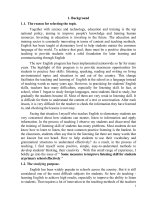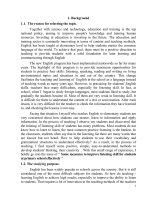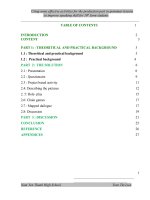Some recommendations to improve translation skill for students majoring in the English language at department of foreign languages – Saigon University
Bạn đang xem bản rút gọn của tài liệu. Xem và tải ngay bản đầy đủ của tài liệu tại đây (358.21 KB, 5 trang )
TRƯỜNG ĐẠI HỌC SÀI GÒN
SAIGON UNIVERSITY
TẠP CHÍ KHOA HỌC
SCIENTIFIC JOURNAL
ĐẠI HỌC SÀI GÒN
OF SAIGON UNIVERSITY
Số 70 (04/2020)
No. 70 (04/2020)
Email: ; Website: />
MỘT SỐ ĐỀ XUẤT GIÚP CẢI THIỆN KỸ NĂNG DỊCH THUẬT
CHO SINH VIÊN NGÀNH NGÔN NGỮ ANH TẠI
KHOA NGOẠI NGỮ – ĐẠI HỌC SÀI GÒN
Some recommendations to improve translation skill for students majoring in the
English language at department of foreign languages – Saigon University
ThS. Đặng Quỳnh Liên
Trường Đại học Sài Gòn
TÓM TẮT
Biên - phiên dịch là định hướng quan trọng đối với sinh viên các chuyên ngành Ngôn ngữ Anh và Sư
phạm tiếng Anh tại Khoa Ngoại ngữ, Trường Đại học Sài Gòn. Sinh viên phải hoàn thành ba học phần:
nhập môn dịch thuật và biên dịch, kỹ năng biên dịch và kỹ năng phiên dịch. Sinh viên học ba học phần
này sau khi tích lũy được một khối lượng kiến thức ngôn ngữ đáng kể, chủ yếu vào năm thứ ba và thứ
tư. Từ các phương pháp và thủ pháp phổ biến trong dịch thuật, người viết xin trình bày một số đề xuất
trong quá trình biên dịch để nâng cao chất lượng bản dịch cho sinh viên.
Từ khóa: định hướng dịch thuật, phương pháp dịch thuật, quy trình dịch thuật
ABSTRACT
Translation - Interpretation is an important orientation for students majoring in the English Language and
English Language Teacher Education at Department of Foreign Languages - Saigon University. Students
have three modules to cover: Introduction to Translation and Interpretation, Translation module and
Interpretation module. All are taught to students after they gather a considerate amount of language
knowledge, mainly in the third and fourth academic year. However, students are still facing many
difficulties during practice process. Based on some translation methods and procedures, I would like to
present some recommendations in translation process in order to improve the quality of their translations.
Keywords: translation orientation, translation methods, translation procedures
According to several translators, in
translation, language knowledge plays a
very important role; it helps to analyze
exactly what are involved in the translation
process from one language to another.
In the framework of formal university
training program of Department of Foreign
Languages - Saigon University, students at
their third and fourth academic year
have to cover three modules in the
1. Introduction
Nowadays, the demand for conversion
of two languages, especially Vietnamese
and English, is increasing with a noticeable
speed due to higher and higher needs
of social exchange and development. This
requires research and resolution on
translation issues not only in practical
aspect but also in scientific reasoning
basis, in other words, translation theories.
Email:
67
SCIENTIFIC JOURNAL OF SAIGON UNIVERSITY
No. 70 (04/2020)
Translation - Interpretation orientation.
They are Introduction to Translation and
Interpretation module, Translation module
and Interpretation module. They are
taught to students at their third and
fourth academic year when the students
accumulate a considerate amount of
language knowledge. However, students
still encounter various problems during
practice process. Based on some translation
methods and procedures and due to time
limitation, I would like to present some
recommendations in only translation
process in order to improve the quality of
their translations.
2. What is translation?
There are many viewpoints presented
by researchers on translation concept
during its developing history.
Translation is usually known as the
process of transferring meaning from the
source language into the target language.
Jeremy Munday (2001:4) states: “The
process of translation between two
different written languages involves the
translator changing an original written text
(the source text or ST) in the original
verbal language (the source language or
SL) into a written text (the target text or
TT) in a different verbal language (the
target language or TL). According to
Larson (1998:5), translation is the research
of vocabulary, structures, communication
situations and cultural context of source
language, analyzing text to define meaning,
then using vocabulary and appropriate
structures in target language in order to
restructure the text in target language.
However, Newmark (1988:5) states that
translation is rendering the meaning of a
text into another language in the way
that the author intended the text.
In general, translation, as the process
of conveying messages across linguistic
and cultural barriers, is an eminently
communicative activity. A diagram of the
communicative relationship in the process
of translation shows that the translator is
both receiver and emitter, the end and the
beginning of two separate but linked chains
of communication:
Author------- Text------- Receiver------- Translator --------Text --------Receiver
In translation from the source language
into the target language, translator needs a
translation way or a translation strategy.
Some translation theorists call them
translation methods such as Newmark
(1988:45) and others regard them as
translation procedures such as Nida (1964).
However,
Newmark
believes
that
translation methods relate to full documents,
while translation procedures are used in
sentences and smaller language units.
3. Some common translation methods
Newmark (1988: 45-48) states that there
are eight translation methods as follows:
3.1. Word- For- Word translation
This is the method of converting
source language into target language just by
serial translation way: word to word, clause
to clause and sentence to sentence. The
source language word-order is preserved
and the words translated singly by their
most common meanings, out of context.
Cultural words are translated literally. This
method of translation is normally effective
only for short simple sentences, for
example, “I play basketball every day” for
“Tôi chơi bóng rổ mỗi ngày.”
3.2. Literal translation
Grammatical structures of the source
language are converted to their nearest
equivalences in the target language but
vocabularies are translated in the most
common meaning, out of context. This
68
ĐẶNG QUỲNH LIÊN
TẠP CHÍ KHOA HỌC ĐẠI HỌC SÀI GÒN
method is used as a pre-translation process and
ranges from word to word, phrase to phrase,
clause to clause and sentence to sentence.
3.3. Free translation
This is translation method which
translators get out of source language’s
constraints, use target language to
paraphrase the meaning of the source
language in a natural way and match target
language’s context and culture. This is the
reason why by this method, the translation
is often longer than the original.
The advantage of this translation
method is that the translation sounds more
natural. On the contrary, its disadvantage is
that as being free, different variations as
compared to the original meaning usually
happen, especially for documents with
spiritual feature such as philosophy,
theology and literature.
3.4. Adaptation
Modulation method means a variation
in the message due to a change in the point
of view: understand something in another
viewpoint. This method is suitable when
translating literally or transposing so that
we have one correct grammar translated
sentence but does not sound naturally in
target language. In modulation method, we
can differentiate free/optional modulation
from fixed/obligatory modulation.
3.5. Idiomatic translation
Metaphor is a method which uses a
specific object that literally implies
something figuratively. Idiom also has the
same character of insinuation. Metaphor and
idiom are often local, national (cultural);
although it is possible to translate, it is
unlikely that strangers will understand the
meaning, if not attach annotation.
3.6. Faithful translation
A faithful translation attempts to
reproduce the precise contextual meaning
of the original within the constraints of the
target language’s grammatical structures.
It “transfers” cultural words and preserves
the degree of grammatical and lexical
“abnormality” in the translation. It tries to
be completely faithful to the intentions of
the source language writer. This method is
used often in documents that need to be
completely correct such as economic
contracts or legal documents.
3.7. Sematic translation
Semantic translation is written at the
author’s linguistic level. It is personal and
individual, follows the thought processes of
the author, tends to over-translate, pursues
nuances of meaning, yet aims at concision
in order to reproduce pragmatic impact.
3.8. Communicative translation
On the contrary, communicative
translation is written at the readership’s
linguistic level. It is social, concentrates on
the message and the main force of the text,
tends to under-translate, to be clear, simple
and brief and is always written in a natural
and resourceful style.
For example:
The source language text: “'I never
hear or read the name of Yarmouth (name
of a town) but I am reminded of a certain
Saturday on the beach...' (extracted from
David Copperfield by Charles Dickens)
Semantic translation: Tôi không bao
giờ nghe hoặc đọc đến tên 'Yarmouth' mà
tôi lại không nhớ đến một sáng thứ bảy nào
đó trên bãi biển (... không bao giờ... mà lại
không...).
Communicative Translation: Cứ mỗi
lần nghe hoặc đọc đến tên 'Yarmouth' thì
tôi lại nhớ đến một sáng thứ bảy nào đó
trên bãi biển (Cứ mỗi lần... thì... lại...).
From my perspective, translator should
avoid Word-for-Word translation and
Literal translation. If the source language
69
SCIENTIFIC JOURNAL OF SAIGON UNIVERSITY
No. 70 (04/2020)
text is too difficult to translate, we can
use Literal method as a pre-translation
process, and then restructure the text in the
target language. For novels or literature
documents, we can apply Free translation
or Adaptation. In economy, education,
health and other social sectors, Faithful
translation can be applied.
If the emphasis is on the source
language, Word-for-Word translation,
Literal translation, Faithful translation and
Semantic translation are used. On the
contrary, Adaptation, Free translation,
Idiomatic translation and Communication
translation are applied in case the translator
focuses on the target language.
4. Some recommendations in the
translation process
Based on the translation methods
discussed above and in order to prevent
mistakes in translation, I would like to
recommend following principles so that we
can enhance translation skill:
1- Before translating a document,
make sure to read it carefully, highlight
difficult-to-translate or not-understandmeaning paragraphs. Please keep in mind
that a word/ phrase may have many
different meanings and expressions,
therefore, translator should direct towards
the meaning which author is referring to in
order to translate correctly.
2- During translation process, in order
to accurately express translated meaning
from Vietnamese into English or vice
versa, use the correct English / Vietnamese
synonym phrase, also use equivalences to
translate phrases and idioms accurately.
For example: "Carry coals to
Newcastle" -> "Chở than đá về Newcastle"=
"chở củi về rừng" (carry coals to the forest)
(Newcastle is a city in England which is
also the World's largest coal exporting port,
it means do not bring back something to an
overabundant place). Or “Ngưu tầm ngưu,
mã tầm mã” can be translated as “Birds of a
feather flock together”.
3- Absolutely avoid completely literal
translation (or word by word) because this
may lead to incorrect translation and
not conveying author's ideas exactly.
Especially, in order to understand text’s
meaning, it is necessary to understand the
intention of the author and meaning in each
sentence, each paragraph, not in each word.
For example” “It was cold enough to
freeze our fingers” -> “Trời đủ lạnh để làm
tê cóng ngón tay của tôi” -> Trời lạnh đến
nỗi ngón tay của tôi tê cóng” (The author
wants to emphasize that cold weather
freezes his/her fingers, not the level of the
coldness).
4- However, we should not avoid
faithful translation because if we translate
too freely, the translation may be unreal
and not close to the original text’s
meaning. Therefore, it is essential to select
and retain necessary ideas and remove
unnecessary ideas, we can re-edit
translated sentences so that they remain
unchanged as compared to the original.
5- Avoid using less common words or
old technical terms which are rarely used
or are unpopular. Only select words that
we know well and readers can easily
understand in translation. Do not use too
exaggerated words; this will make readers
confused and does not ensure an effective
translation.
6- Do not use too many synonyms in a
translated document; this will make the
translation become incoherent.
7- During translation process, when
encountering complex sentences which are
difficult to translate, split them into short
sentences, it will be easier. However, make
70
ĐẶNG QUỲNH LIÊN
TẠP CHÍ KHOA HỌC ĐẠI HỌC SÀI GÒN
sure to keep the meaning unchanged so that
when joining together, the paragraphs will
have the same meaning as compared to the
original.
For example: “Thousands of Algerians
tonight fled from the dead city of
Orleansville after a 12-second earthquake
had ripped through central Algeria,billing
an estimated death toll of 1,100 people.”
“Đêm nay tại trung tâm Angieri đã xảy
ra một trận động đất kéo dài 12 giây đồng
hồ. Theo ước tính thì số người bị thiệt
mạng lên đến 1.100 người. Hàng ngàn
người khác đã chạy khỏi thành phố
Orleansville đầy tang tóc đó.”
8- After pre-translation process, always
ensure that sentences in the translated text
are coherent and connected to each other.
The style of the target language text must be
clear and still keep accurate meaning as
compared to the original.
9- In addition to practicing and
improving the above-mentioned skills, it is
necessary to read and learn more about
English used in many different fields:
English for Business, English for Banking,
English for Construction, English for
Medicine, English for Environmental
Studies... for a better understanding to
support English translation process.
5. Conclusion
Good translators need a variety of
knowledge including background knowledge
of both languages and professional
knowledge of the fields they are translating.
They need to be proficient, have a rich
vocabulary, a thorough understanding of
linguistic issues of both languages,
understand the similarities and differences
between the two languages not only in term
of grammar but also in terms of semantics
and pragmatics. These insights are closely
linked with cultural knowledge about
country, people, lifestyles, habits, customs
and practices of the two language
communities. Finally, each field has its
own terminologies, expressions, and styles,
requiring translators to understand at least
their meaning and connotation, although it
cannot be as deep as a specialist. The
requirements for a translator on such
knowledge are not easy for students who
have just started taking translation courses.
However, some of the principles and noted
issues during translation process mentioned
above may contribute to facilitating
students more during their translation
practice process.
REFERENCES
Larson, M.L. (1998). Meaning-based Translation: A Guide to Cross-language
Equivalence. Oxford: University Press of America.
Munday, J. (2001). Introducing Translation Studies. New York: Routledge.
Newmark, P. (1981). Approaches to translation. New York: Pergamon Press Ltd.
Newmark, P. (1988). A textbook of translation. New York and London: Prentice Hall
International (UK) Ltd.
Nida, E. A. (1964). Toward the Science of Translating: With special reference to
principles and procedures involved in Bible translating. Leiden: E. J. Brill.
Ngày nhận bài: 13/3/2020
Biên tập xong: 15/4/2020
71
Duyệt đăng: 20/4/2020









